
Traveling to Campania: Essential Tips and Where to Stay in Sorrento

On the morning of our last full day in Naples, we woke up well-rested and ready for adventure. After indulging in a delicious and hearty breakfast, we set out to explore the city’s historic center. Naples is one of Europe’s oldest and most historically significant cities, once the capital of an ancient kingdom.
The locals take immense pride in their roots and heritage, preserving them in a way that makes Naples a truly unique experience. Nowhere else can you feel this atmosphere quite like here.
Even though we dedicated an entire day to exploring, it wasn’t nearly enough to see everything we had hoped for. The best way to soak in Naples’ authentic charm is on foot, so we spent the day strolling through its vibrant streets.
Walking to the Cathedral – The City Awakens
Our first destination was the renowned Naples Cathedral (Duomo di Napoli), just a 15-minute walk from our accommodation. Even in the early hours, the city was already buzzing with life: scooters weaved through the narrow streets at a dizzying speed, the aroma of fresh coffee and pastries filled the air, and locals gathered at tiny cafés, deep in conversation over a strong espresso.
We strolled along Via Tribunali, one of Naples’ most iconic and lively streets. Along the way, we passed charming boutiques, hidden chapels, and historic palaces, each telling a story of the city’s rich past and authentic character.
It didn’t take long before we reached the majestic façade of the cathedral, standing proudly before us.
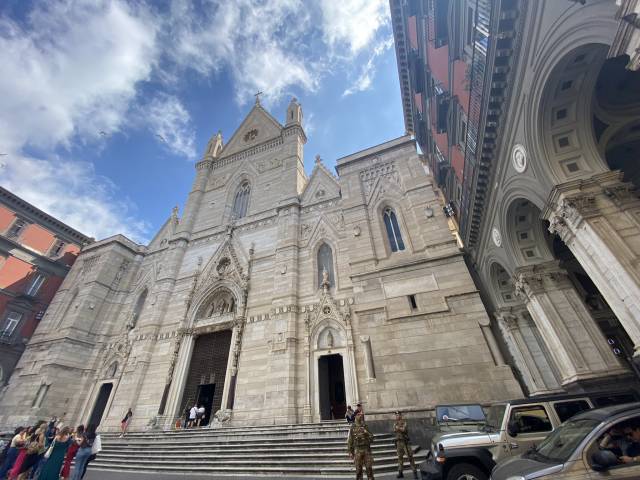
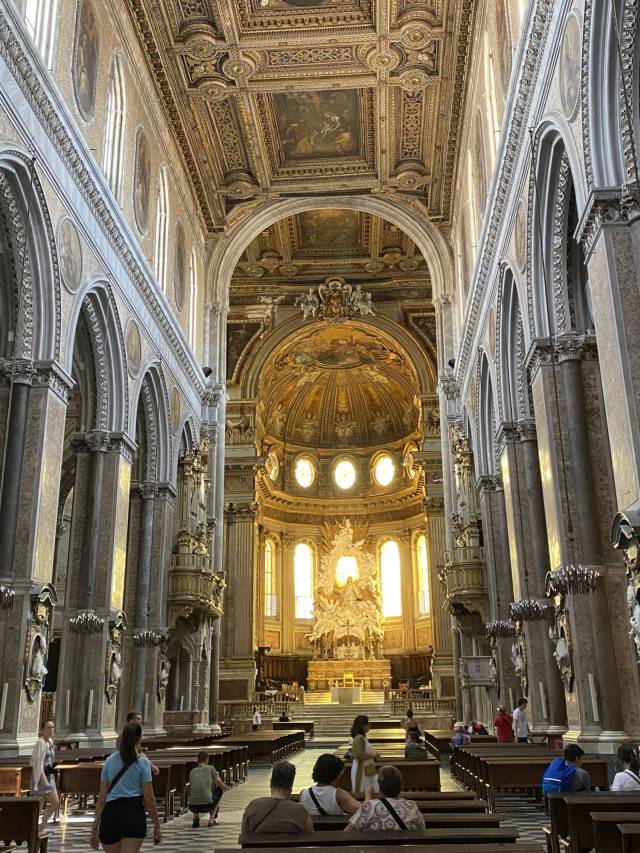
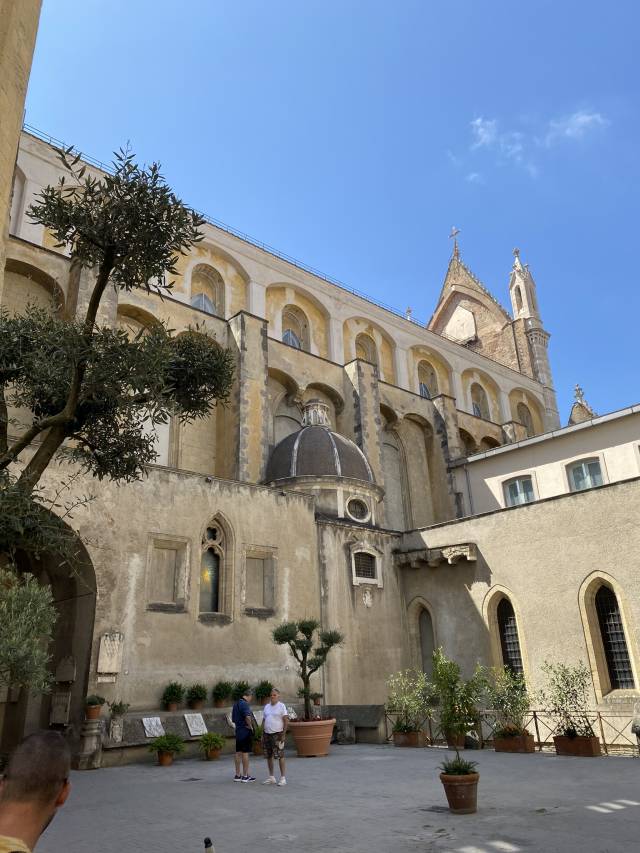
The Naples Cathedral, also known as the Cathedral of Saint Januarius (Cattedrale di San Gennaro), is the city’s most important church and a key religious landmark. Located in the heart of Naples’ old town, it is dedicated to Saint Januarius (San Gennaro), the city’s patron saint.
Useful Tips:
Entry to the cathedral is free, but tickets are required to visit the treasury and chapel.
As a place of worship, appropriate attire (covering shoulders and knees) is recommended.
Stepping inside, we were immediately captivated by the cathedral’s grandiose interior and the intricate frescoes adorning its ceilings.
One of the most sacred parts of the cathedral is the Chapel of the Treasury of Saint Januarius (Cappella del Tesoro di San Gennaro), which houses the saint’s relics, including the famous blood relic. This relic is one of Naples’ most treasured religious artifacts, drawing huge crowds each year to witness the legendary “Miracle of the Blood”, when the dried blood of the saint is said to liquefy.
Beyond its religious significance, the Naples Cathedral is an architectural and cultural masterpiece—an absolute must-see when visiting the city.
After leaving the cathedral, we continued our journey through Naples’ maze-like streets, searching for more hidden treasures. Our next stop: Spaccanapoli, the street that quite literally „splits Naples in half.”
Via San Gregorio Armeno – The Street of Nativity Scenes
Returning to Via Tribunali, we turned left onto Via San Gregorio Armeno, one of Naples’ most unique pedestrian streets. Having read so much about it before our trip, we knew we had to see it for ourselves!
This is no ordinary shopping street—it’s the heart of Naples’ artisan tradition, also known as “Via dei Presepi” (The Street of Nativity Scenes). For centuries, local craftsmen have passed down their skills from generation to generation, creating meticulously handcrafted nativity figurines and miniature scenes.

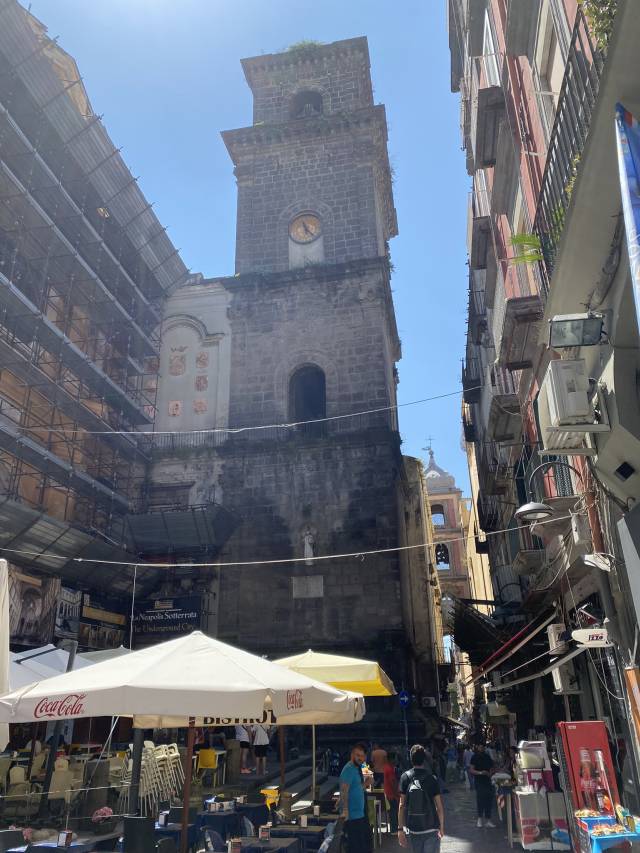
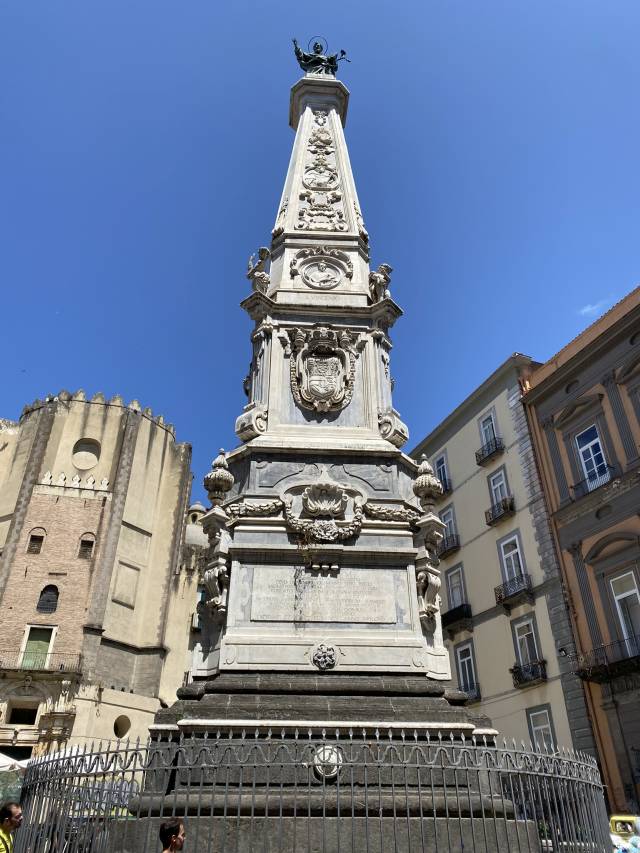
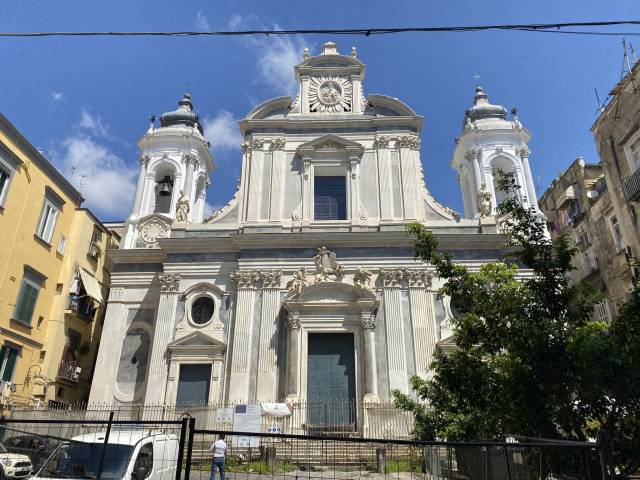
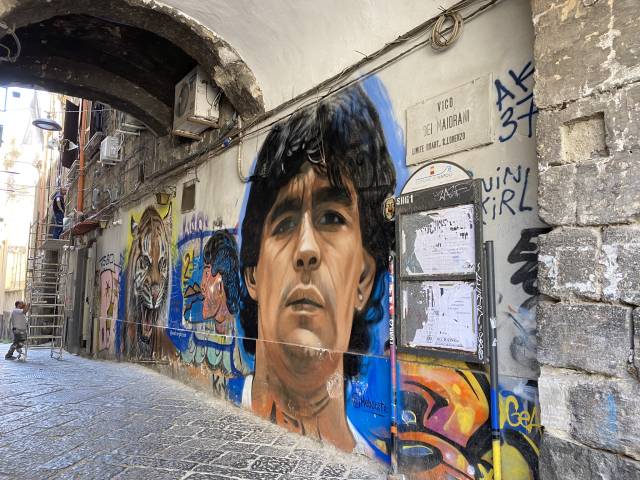
The Magical World of Neapolitan Nativity Scenes
Via San Gregorio Armeno is the epicenter of Neapolitan nativity craftsmanship. Open all year round, its shops overflow with beautifully carved and hand-painted figurines, from traditional nativity characters like shepherds and angels to intricate Christmas decorations.
But what makes Neapolitan nativity scenes truly special is their modern and humorous twist. Alongside the classic religious figures, you’ll often find miniature versions of celebrities, politicians, football stars, or even movie characters, adding a playful and unexpected charm to the tradition.
The Bustling Atmosphere of the Artisan Quarter
The narrow alleyway was packed with visitors, all admiring the incredible craftsmanship of the local artisans. We were fascinated by their meticulous work and enjoyed browsing the one-of-a-kind souvenirs. Beyond nativity figures, the shops also sold Neapolitan trinkets, handcrafted decorations, and lucky charms—perfect keepsakes to take home.
This street is a must-visit for anyone wanting to experience Naples’ rich artisan traditions up close and take home a little piece of its magic.
Piazza San Domenico Maggiore and the Sansevero Chapel
As we continued our walk along Via San Biagio dei Librai, we arrived at Piazza San Domenico Maggiore. At the center of the square stands an obelisk commemorating the plague of 1656. Dominating the square is the San Domenico Maggiore Church, one of Naples’ largest churches. Once the spiritual home of the Aragonese nobility, it holds great religious and artistic significance. Inside, you’ll find the tombs of the Aragonese kings, adding to the church’s historical weight.
Just a few minutes’ walk from here is the Sansevero Chapel, also known as Museo Cappella Sansevero. This chapel is renowned for its breathtaking artworks, most famously the „Veiled Christ” (Cristo Velato) sculpture by Giuseppe Sanmartino. This masterpiece is widely regarded as one of Naples’ greatest artistic treasures.
Although visiting the Sansevero Chapel was on our itinerary, we weren’t able to go inside this time. Our little one, Liny, had fallen asleep in the stroller, and since we hadn’t purchased tickets in advance, we were met with a long, winding queue at the entrance. We decided to save this special place for another trip to Naples, when we could fully immerse ourselves in its artistic wonders without rushing.
The Gesù Nuovo Church and the Santa Chiara Monastery
Our next stop was the Gesù Nuovo, the Jesuit church of Naples. Interestingly, it was not originally built as a church—it was once a palace belonging to the noble Sansevero family. Its exterior is truly unique, covered in dark, pyramid-shaped stone blocks, making it stand out from traditional church facades. However, stepping inside reveals an entirely different world: lavish golden frescoes, intricate marble inlays, and an overwhelming sense of grandeur.
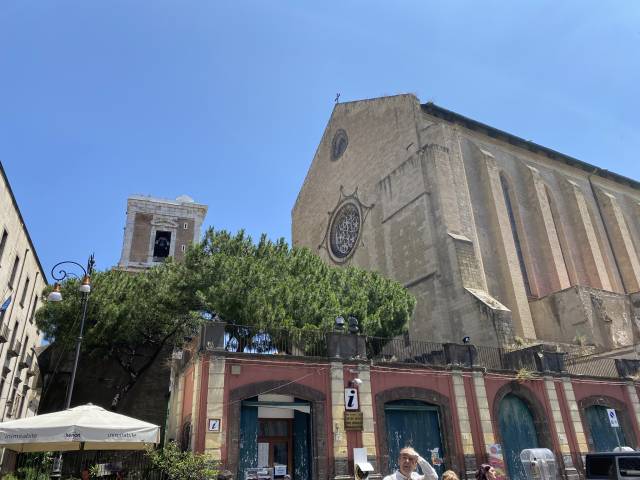
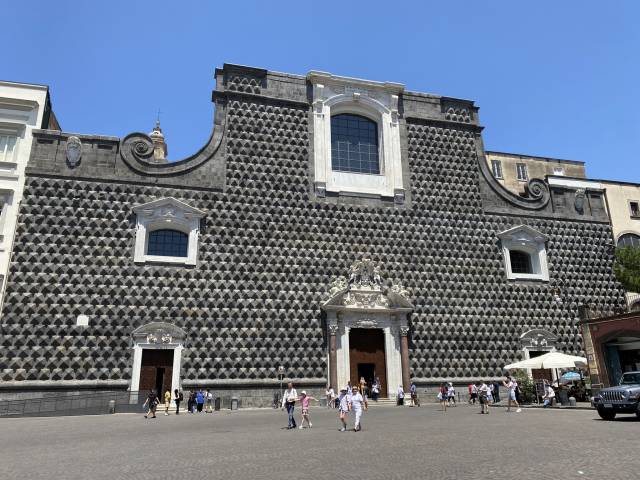
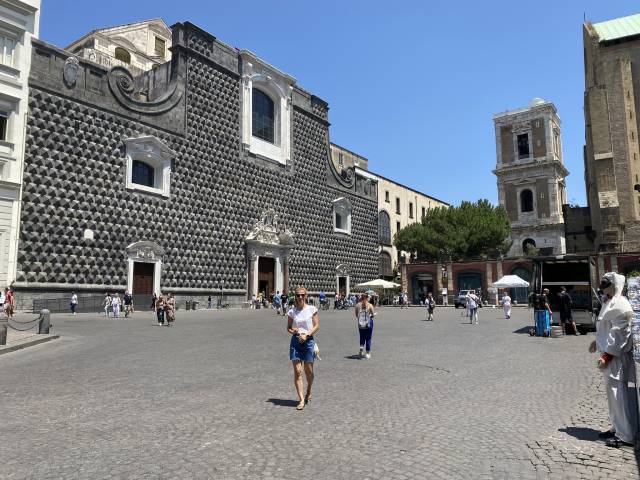
Right across from the Gesù Nuovo stands one of Naples’ most remarkable monasteries, Santa Chiara. This historic complex served as the burial site of the Anjou kings and later the Bourbon rulers. The monastery is especially famous for its majolica-tiled courtyard, adorned with beautifully painted ceramic columns. Walking through this peaceful oasis felt like stepping into another world, a stark contrast to the city’s bustling streets.
A Relaxing Break at Piazza del Gesù Nuovo
The Piazza del Gesù Nuovo, where these historical landmarks stand, is one of Naples’ most beautiful squares. At its center rises the Guglia dell’Immacolata, a striking Baroque column dedicated to the Virgin Mary, which has graced the square since the 1700s. This piazza is considered the heart of Naples’ historic center, where history, religion, and the city’s vibrant daily life seamlessly intertwine.
We took a well-deserved break at Trinity Café, a cozy spot on the corner of the square. We ordered a pistachio croissant, bruschetta, coffee, and soft drinks, all of which were absolutely delicious. The quality-to-price ratio was excellent, and the staff was incredibly friendly. Meanwhile, Liny continued to sleep peacefully in the stroller, giving us a quiet moment to enjoy the lively yet relaxed atmosphere of the piazza.
Reenergized, we set off once again, eager to dive even deeper into Naples’ enchanting charm.
Via Toledo – Naples’ Most Famous Shopping Street
Via Toledo is Naples’ bustling shopping street, stretching over a kilometer through the heart of the city. After finishing our break at Trinity Café on Calata Trinità Maggiore, we made our way toward Via Toledo. Before reaching the main avenue, we took a brief stop at Piazza Monteoliveto, a small yet charming square. This marked the end of Spaccanapoli, the famous street that cuts through Naples’ historic center.
In the middle of the square stands the Fontana di Monteoliveto, a fountain featuring a statue of the young King Charles II, known as „Carluccio.”
From here, we were ready to explore the lively and vibrant Via Toledo!
Shopping and Vibrant City Life
Via Toledo is a paradise for fashion and shopping lovers. It’s home to international brands, Italian fashion houses, and charming local boutiques. The street was full of life: street musicians, artists, and a lively mix of tourists created an unforgettable atmosphere.
There were plenty of tempting bakeries along the street, and in one of them, we tried a sfogliatella pastry—absolutely delicious!
Galleria Umberto I – The Elegance of Naples
One of the entrances to Naples’ most elegant shopping gallery, Galleria Umberto I, opens onto Via Toledo. As we stepped inside, we were greeted by luxury stores, charming cafés, and breathtaking architecture. The gallery’s enormous glass dome and intricate ironwork are truly mesmerizing, reminiscent of Milan’s famous Galleria Vittorio Emanuele II. Beneath the dome, the floor features zodiac signs, adding to the artistic beauty of the space.
Inside, you’ll find a selection of high-end fashion boutiques, cozy cafés, restaurants, and pastry shops—perfect for sipping coffee or enjoying a sweet treat while admiring the gallery’s grandeur.
Historical Sights Nearby
Via Toledo offers more than just shopping—it also boasts remarkable landmarks, such as the Toledo Metro Station, often regarded as one of the most beautiful subway stations in the world. Though we didn’t visit it this time, if you have the chance, it’s worth stopping by to admire its stunning modern art installations and mesmerizing blue mosaic walls.
Exiting the Galleria, we continued along Via Toledo until we reached the iconic Piazza del Plebiscito.
Piazza del Plebiscito – The Iconic Heart of Naples
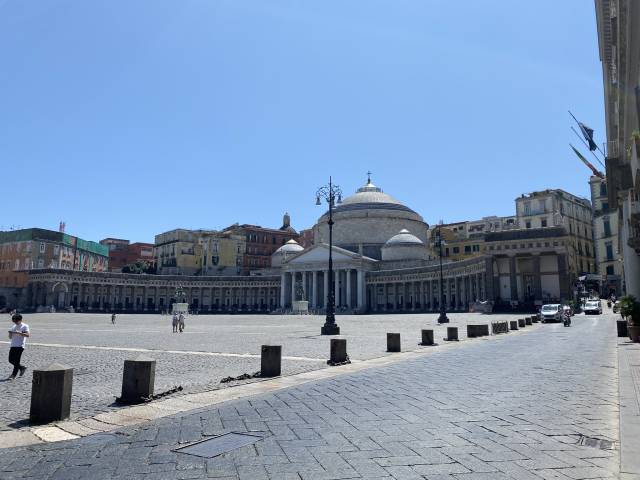
Piazza del Plebiscito (formerly known as Largo di Palazzo) is the largest square in Naples, surrounded by historic landmarks. Among them, you’ll find:
A Lively Atmosphere & Things to Do at Piazza del Plebiscito
The vast, open space of Piazza del Plebiscito is always bustling with energy. It frequently hosts concerts, cultural events, and celebrations, so there’s always something exciting happening. The square is also a fantastic spot for photography, and the nearby cafés are perfect for a relaxing coffee break.
We were tempted to stop for a drink but decided to skip it since we had just indulged in the heavenly sfogliatella pastry. Our little one, Liny, loved the freedom of the open space. After spending much of the day in her stroller, she finally had the chance to run around and play while we soaked in the vibrant atmosphere.
Strolling Towards Castel dell’Ovo
Since Liny was still eager to walk, we decided to continue our journey on foot toward Castel dell’Ovo, Naples’ oldest fortress. The walk from Piazza del Plebiscito led us to a stunning coastal promenade.
The Castel dell’Ovo (or “Egg Castle”) is one of Naples’ most famous landmarks, located on the small island of Megaride. From the fortress, we enjoyed breathtaking views of the sea, Mount Vesuvius, and the city skyline—an excellent spot for photography. Although we didn’t go to the beach that day, we fully embraced the coastal ambiance and took a short break to admire the scenery.

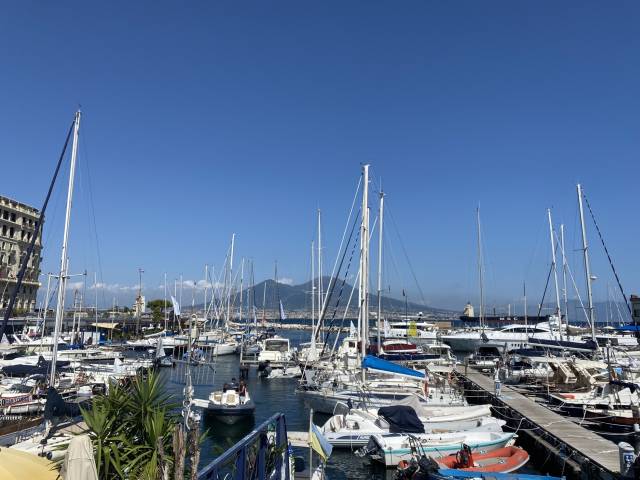
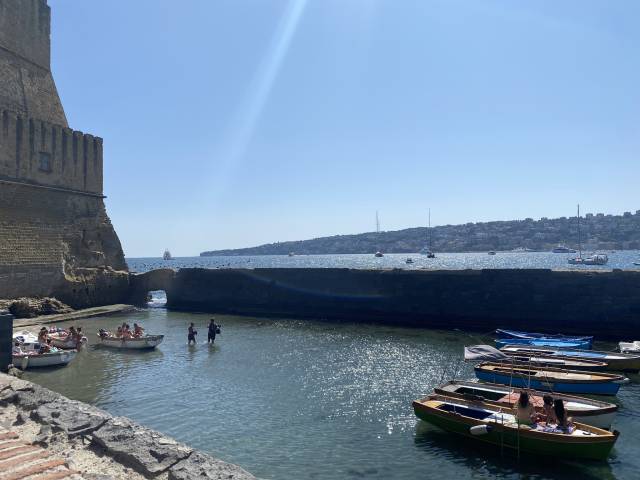
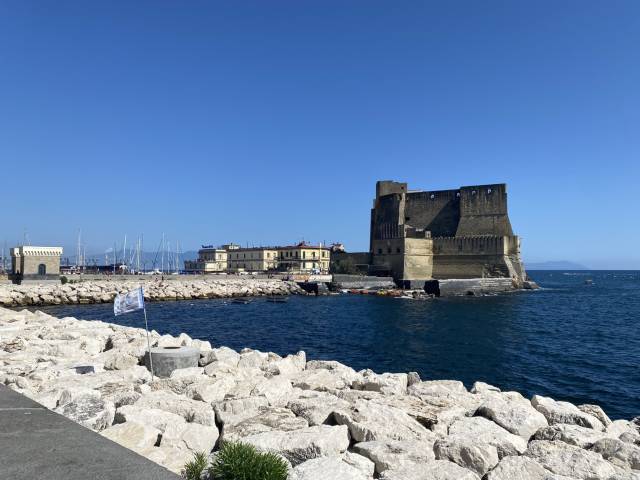
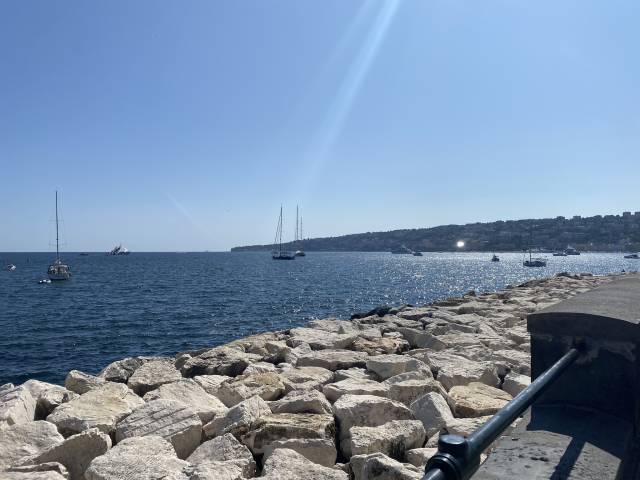
From there, we continued along the famous Via Partenope, part of the Lungomare di Napoli, one of the city’s most beautiful waterfronts. Our next destination was Villa Comunale, a lovely city park ideal for a relaxing pause.
A Restful Break at Villa Comunale Park
Even in the afternoon, the sun was still strong, and after a full day of exploring, we were starting to feel tired. Villa Comunale, nestled between Piazza Vittoria and Piazza della Repubblica, was a welcome retreat.
The park offers plenty of shade under its majestic oak, pine, palm, and eucalyptus trees. We were grateful for the cool breeze as we strolled past Renaissance-style fountains and statues of famous historical figures. Villa Comunale is also home to the Naples Aquarium (Acquario di Napoli), one of the oldest in Europe.
We took some time to unwind, enjoyed a refreshing gelato, and, around 5 PM, decided to head back to our accommodation for the last dinner of our trip.
Heading Back & Dinner at an Authentic Neapolitan Pizzeria
We took a bus back to our accommodation, boarding the 151 bus at Piazza Vittoria. The ride was smooth, and we got off just a short 7–8 minute walk from our stay.
Tip: Be extra cautious about pickpockets when using public transport in Naples. While waiting for the bus, a local even warned us about the high number of “pick packers” (as they call them), so keeping an eye on valuables is a must!
For our final dinner in Naples, we wanted to try an authentic Neapolitan pizza. Naturally, our first stop was the legendary L’Antica Pizzeria Da Michele—one of the most famous pizzerias in Naples, renowned for serving what many consider to be the best Margherita pizza in the world.
As expected, there was a long queue, with an estimated 1–1.5 hour wait. Since we were traveling with a small child, we decided to skip the wait and instead walked over to Pizzeria D’Angeli, just across the street. Here, we were seated immediately. The pizza was fantastic, the tomato sauce especially flavorful, and the staff was warm and welcoming.
We ended our final evening in Naples on a high note, savoring the flavors of authentic Italian cuisine and reflecting on the unforgettable memories of our trip. 😊
The Next Morning – An Early Departure
The next day, we had an early flight, so we pre-booked a 6 AM taxi, recommended by our host. The taxi arrived right on time and took us to the airport in just 15 minutes. Our flight departed punctually, marking the end of our wonderful Naples adventure.
@ Copyright - WanderingKite | All rights reserved! | Privacy Policy